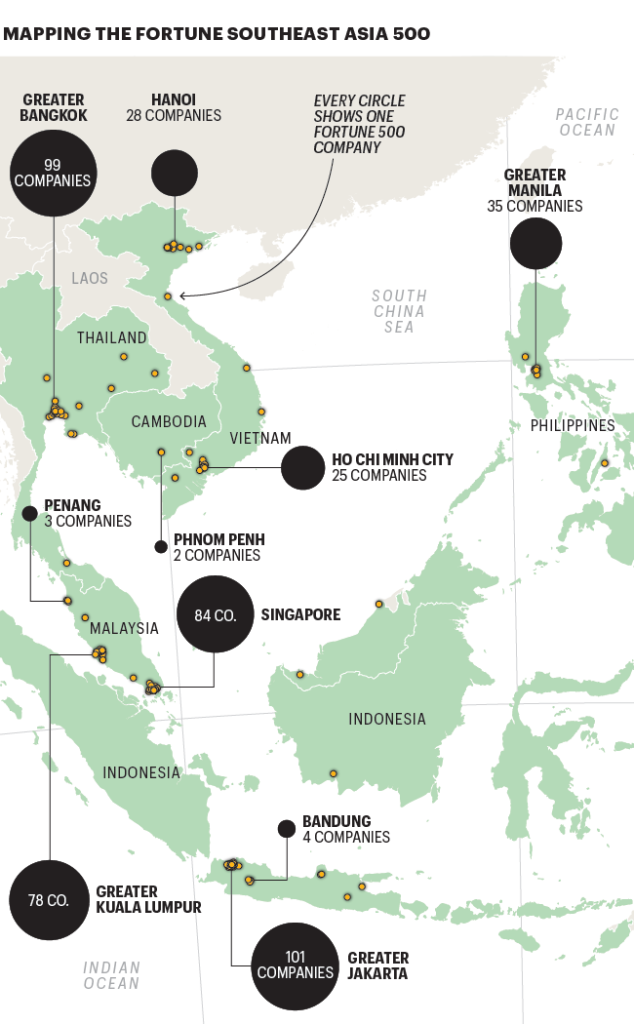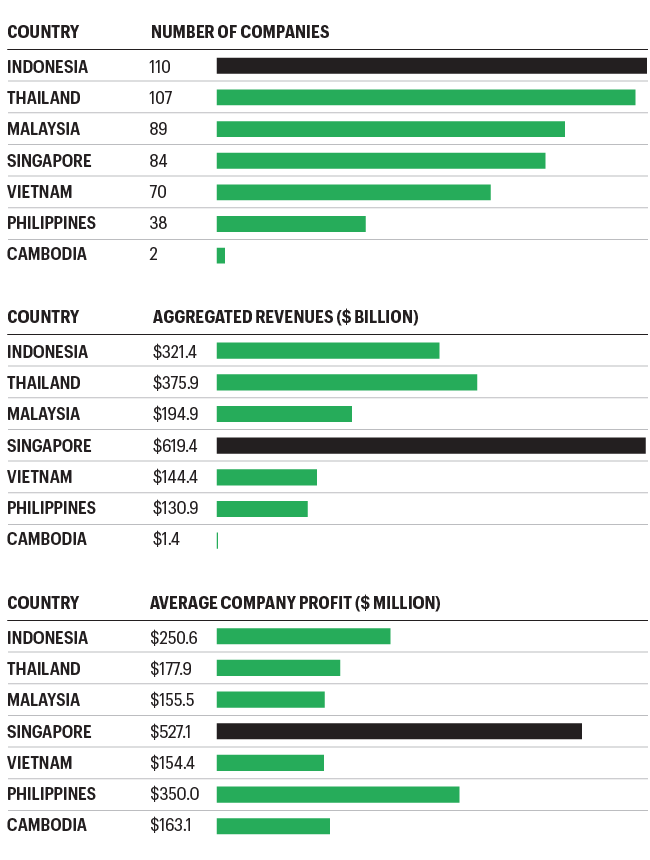Introducing Fortune’s first-ever Southeast Asia 500: Firms that mine stuff, make stuff, and move stuff dominate a fast-growing region
The inaugural Fortune Southeast Asia 500 list, our first-ever ranking of the largest companies in this part of the world, reflects a dynamic and fast-changing region—one that boasts a GDP of $4 trillion, and one whose core economies are growing notably faster than those of Europe or the U.S.
Southeast Asia is also taking on far greater significance in the global economy. In the wake of the COVID pandemic, a host of Global 500 multinationals have shifted more of their supply chains to Southeast Asian nations. Foreign direct investment to the region is soaring. And with a young and growing population of 680 million, low inflation, and stable exchange rates, Southeast Asia is emerging as an attractive market in its own right.
A defining feature of the Southeast Asia 500 is its domination by a handful of giant firms with far-flung global operations. But greater exposure to overseas markets may explain why Southeast Asia’s largest companies saw their revenue shrink last year even as regional economies grew.
In total, companies on the Fortune Southeast Asia 500 took in $1.79 trillion in revenue in 2023, a drop of $45 billion, or 2.5%, from the previous year. Earnings shrank to nearly $130 billion, down $13.9 billion, or 9.6%, from 2022.
The declines contrasted with the relative resilience of the region’s six core economies. Those nations—Indonesia, Thailand, Malaysia, Singapore, Vietnam, and the Philippines—all grew their GDP last year, accelerating at a collective pace of 4.2%, down from 5.5% in 2022, according to the International Monetary Fund.

A deeper dive into the list helps explain the discrepancy. Only five companies on the Southeast Asia 500 were large enough to have made the 2023 edition of the Fortune Global 500, for which the revenue threshold was $30.9 billion. By comparison, that list included 119 companies from Europe, 136 from the U.S., and 142 from China including Hong Kong and Taiwan.
But those top five companies—which include three huge Singapore-based commodities trading houses (Trafigura Group, Olam Group, and Wilmar International) and two state-owned oil and gas producers (Thailand’s PTT and Indonesia’s Pertamina)—loom large compared with regional peers, accounting for 26% of revenue generated by companies on the list. In 2023, these giants were buffeted by geopolitical conflict, supply-chain shocks, and uncertainty in markets like China and Europe; all five reported lower revenue in 2023 owing to weaker global demand for energy.
The upshot: As a group, their revenue shrank 16%. In contrast, the 495 companies that account for the remaining 74% of the list’s revenue increased sales by about 4%.
Some of the giants also grew earnings even as revenue shrank. Trafigura, by far the largest company on the list, highlighted the paradox, raking in a record $7.4 billion in earnings while revenue plunged 23%. No. 2–ranked PTT posted $3.2 billion in earnings, up more than 23% from 2022, despite a revenue decline of 6%.
Banks and financial services firms fared well last year. The region’s three largest banks—all based in Singapore—each reported revenue gains of more than 60%. DBS Group was Southeast Asia’s most profitable company, with earnings of $7.5 billion. Nine of the list’s 20 most profitable companies were banks.
Airlines and airports also prospered as the region continued to rebound from COVID. Revenue nearly doubled at Singapore’s Changi Airport Group, while Airports of Thailand and Thailand’s Asia Aviation saw even bigger percentage increases in revenue.
The five biggest companies on the list accounted for 26% of the revenue generated by this year's roster.
Consumer internet platforms, hit hard by the pandemic, came roaring back in 2023. But the profit picture was mixed. Singapore-based Sea, which also owns a digital-payments provider and runs an online gaming platform, posted its first profit. Crosstown rival Grab Holdings reduced losses to $434 million, down from a loss of $1.7 billion the previous year. Indonesia’s top “super app” provider, GoTo, incurred the biggest loss of any company on the list, slipping $5.9 billion into the red. The loss was mostly attributable to a $4.9 billion write-down that resulted when GoTo surrendered a controlling stake in Tokopedia, its online shopping business, to the TikTok unit of Chinese social media company ByteDance.
Trafigura, with $244 billion in revenue, dominates the Southeast Asia 500; no other company in the region reported revenue of over $100 billion. Founded in Geneva in 1993, Trafigura has evolved into a sprawling trading firm that moves oil, gas, metals, power, and bulk commodities around the world and does business in 150 countries. The company moved its legal headquarters to Singapore in 2012 to take advantage of the country’s low tax rates. Privately held, Trafigura says it has about 1,200 shareholders, almost all of whom are its employees. In December, the company announced that it would pay a record dividend of $5.9 billion, or about $5 million per shareholder.
There was less to celebrate at the other Singapore-based commodities giants. Wilmar International, one of the world’s largest producers of palm oil, sugar, flour, and other food products, reported a near 37% decline in profit. At Olam Group, which was founded in Nigeria as a cashew export business and relocated to Singapore in 1995, profits fell 55%.
The Southeast Asia 500’s largest manufacturer was Flex, which ranked No. 8 overall with revenues of $26.4 billion. Flex turns out a vast array of products including computers, ventilators, auto components, power tools, and vacuum cleaners, from more than 100 manufacturing facilities in 30 countries. Though founded in Silicon Valley and headquartered in Austin, Flex appears on the Southeast Asia 500 because since 1990 it has been incorporated in Singapore. Flex CEO Revathi Advaithi is one of 30 women who currently hold the role of chief executive at a Southeast Asia 500 company.
In compiling the Southeast Asia 500, Fortune surveyed companies in the region’s six core economies plus Cambodia. Indonesia, with a population of 280 million and a GDP of $1.5 trillion, claimed the largest number of companies on the list, with 110. Thailand, with 70 million people and a $550 billion economy, came in a close second with 107. Singapore, with only 5.6 million people, punches way above its weight on the Southeast Asia 500, fielding 84 companies.
Vietnam, one of the region’s fastest-growing economies, was home to 70 companies on the list. The largest of those was state-owned Petrolimex (No. 23 overall), with revenues of $11.5 billion.

A historically minded reader can find parallels between this list and the inaugural U.S. Fortune 500, from 1955. As with Southeast Asia’s rankings today, the top echelons of the first U.S. list were dominated by producers of major commodities: Four of the top 10 in 1955 were oil producers, for example, and two were steelmakers.
Almost 70 years later, oil and steel still matter in the U.S. economy, but retail, tech, and health care dominate the Fortune 500. There’s no way to know if or when those industries might supplant Southeast Asia’s Big Five. But the Southeast Asia 500 will track their ascent and descent as it chronicles this fast-changing region in the years to come.
This article appears in the June/July 2024 Asia issue of Fortune with the headline, “500 companies to watch in a region on the rise.”
This story was originally featured on Fortune.com

 Yahoo Finance
Yahoo Finance